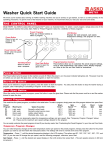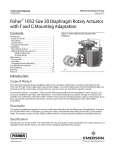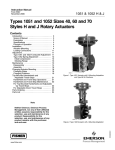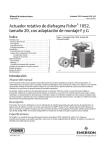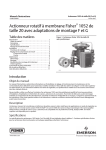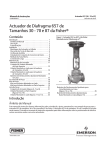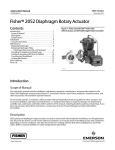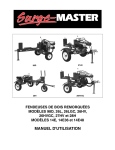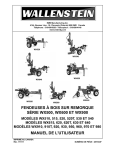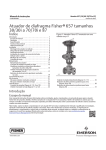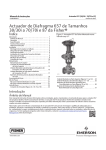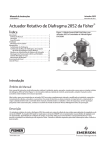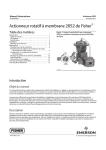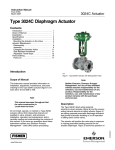Download Emerson Fisher 1051 and 1052 Installation Instructions
Transcript
Instruction Manual 1052 Size 20 Actuator (H) D100323X012 September 2012 Fisherr 1052 Size 20 Diaphragm Rotary Actuator with H Mounting Adaptation Contents Introduction . . . . . . . . . . . . . . . . . . . . . . . . . . . . . . . . . 1 Scope of Manual . . . . . . . . . . . . . . . . . . . . . . . . . . . . . 1 Description . . . . . . . . . . . . . . . . . . . . . . . . . . . . . . . . . 2 Specifications . . . . . . . . . . . . . . . . . . . . . . . . . . . . . . . 2 Installation . . . . . . . . . . . . . . . . . . . . . . . . . . . . . . . . . . 3 Spring Compression Adjustment . . . . . . . . . . . . . . . 3 Initial Spring Compression . . . . . . . . . . . . . . . . . 3 Stroking Range . . . . . . . . . . . . . . . . . . . . . . . . . . 4 Mounting Procedure . . . . . . . . . . . . . . . . . . . . . . . . . 4 Principle of Operation . . . . . . . . . . . . . . . . . . . . . . . . 5 Maintenance . . . . . . . . . . . . . . . . . . . . . . . . . . . . . . . . . 6 Disassembly . . . . . . . . . . . . . . . . . . . . . . . . . . . . . . . . 6 Assembly . . . . . . . . . . . . . . . . . . . . . . . . . . . . . . . . . . . 8 Changing Actuator Mounting . . . . . . . . . . . . . . . . . . 9 Changing Styles . . . . . . . . . . . . . . . . . . . . . . . . . . . . . 9 Changing Positions . . . . . . . . . . . . . . . . . . . . . . . . . 11 Top Mounted Handwheel . . . . . . . . . . . . . . . . . . . . . 11 Disassembly . . . . . . . . . . . . . . . . . . . . . . . . . . . . . . . 12 Assembly . . . . . . . . . . . . . . . . . . . . . . . . . . . . . . . . . . 12 Parts Ordering . . . . . . . . . . . . . . . . . . . . . . . . . . . . . . . 12 Parts List . . . . . . . . . . . . . . . . . . . . . . . . . . . . . . . . . . . 13 Figure 1. Fisher 1052 Size 20 Actuator with H Mounting Adaptation W4140-1 Introduction Scope of Manual This instruction manual includes installation, adjustment, operation, maintenance, and parts ordering information for the Fisher 1052 size 20 diaphragm rotary actuator with H mounting (figure 1) and the optional top-mounted handwheel (see figure 7). Instructions for the rotary positioner and other accessories are included in separate instruction manuals. Do not install, operate, or maintain a 1052 actuator without being fully trained and qualified in valve, actuator, and accessory installation, operation, and maintenance. To avoid personal injury or property damage, it is important to carefully read, understand, and follow all the contents of this manual, including all safety cautions and warnings. If you have any questions about these instructions, contact your Emerson Process Management sales office before proceeding. www.Fisher.com Instruction Manual 1052 Size 20 Actuator (H) September 2012 D100323X012 Table 1. Specifications Operating Principle Direct-Increasing loading pressure forces the diaphragm rod from the top to the bottom of the casing Casing Pressure Ranges J 0 to 1.2 bar (10 to 18 psig), J 0 to 2.3 bar (0 to 33 psig), or J 0 to 2.8 bar (0 to 40 psig) depending on spring used for proportional control; up to 3.4 bar (50 psig) for on-off control Maximum Allowable Sizing Pressure(1) 3.4 bar (50 psig) Maximum Rotation 90 degrees (travel is adjustable between 60 degrees and 90 degrees by travel stops) Maximum Allowable Output Torque 58 NSm (515 lbfSin) Stroking Time Depends on degrees of rotation, spring rate, initial spring compression, and supply pressure. If stroking time is critical, consult your Emerson Process Management sales office Material Temperature Capabilities(1) -40 to 180_F (-40 to 82_C) Pressure Connections 1/4 NPT internal Mounting Configurations See figure 5 Approximate Weight 13.6 kg (30 lb) Top-Mounted Handwheel Specifications Operating Principle: Can be used for manual operation of the actuator or as an adjustable up travel stop Diameter: 171 mm (6.75 inches) 1. Use this value to determine the maximum torque output. The pressure-temperature limits in this manual and any applicable code or standard should not be exceeded. Description The 1052 size 20 spring-and-diaphragm actuator is used on small rotary shaft valves and other equipment for throttling or on-off control applications. This actuator accepts a 3610J, 3620J, or PMV positioner, and a top-mounted handwheel is available for the unit. The Style H mounting adaptation permits the actuator to be used with user-provided mounting brackets and couplings for rotary actuation of equipment other than Fisher valves. This mounting adaptation includes a flat-surface actuator mounting plate that is drilled and tapped for attaching the user-provided bracket. Cap screws for attaching the bracket are provided. The H mounting also includes an output shaft (with two milled flats) to provide the rotary output, either directly or through a user-provided coupling. Dimensional information for the mounting plate and output shaft are shown in figure 4. Specifications Specifications are shown in table 1 for 1052, Size 20, Style H actuators. Some specifications for a given actuator as it originally comes from the factory are stamped on a nameplate attached to the actuator. 2 Instruction Manual D100323X012 1052 Size 20 Actuator (H) September 2012 Installation WARNING Always wear protective gloves, clothing, and eyewear when performing any maintenance operations to avoid personal injury. Personal injury or equipment damage caused by sudden release of pressure might result if the valve assembly is installed where service conditions could exceed the limits given in table 1 or on the appropriate nameplates. To avoid such injury or damage, provide a relief valve for overpressure protection as required by government or accepted industry codes and good engineering practices. Check with your process or safety engineer for any additional measures that must be taken to protect against process media. If installing into an existing application, also refer to the WARNING at the beginning of the Maintenance section in this instruction manual. CAUTION To avoid parts damage, do not use an operating pressure that exceeds the Maximum Diaphragm Casing Pressure (table 1) or produces a torque greater than the Maximum Allowable Valve Shaft Torque (see Catalog 14). Use pressure-limiting or pressure-relieving devices to prevent the diaphragm casing pressure from exceeding its limit. A 1/4 NPT pressure connection is located on top of the actuator. Run either NPS 1/4 pipe or 3/8-inch tubing between the pressure connection and the instrument. Keep the length of tubing or pipe as short as possible to avoid transmission lag in the control signal. If a positioner is used, the pressure connection to the actuator is normally made at the factory. When the actuator is completely installed and connected to the instrument, check it for correct action (air-to-open or air-to-close) to match the controlling instrument. For successful operation, the actuator rod and equipment operating shaft must move freely in response to the loading pressure change on the diaphragm. Spring Compression Adjustment Spring adjustment is shown in figure 2. Key numbers are shown in figure 6. Initial Spring Compression The 1052 nameplate specifies a SPRING INITIAL SET, which is the initial compression adjusted into the actuator spring. Initial compression is the casing pressure at which the diaphragm (key 3) and diaphragm rod (key 10) begin to move away from the up travel stop. The initial compression is selected (based upon the service conditions specified when the actuator was ordered) so that when the actuator is in service on the operated equipment, the equipment closes properly and full travel is obtained within a specified casing range. If the actuator has been disassembled, or if the spring adjustment was changed, do NOT adjust the initial compression to exceed the SPRING INITIAL SET value on the nameplate. 3 Instruction Manual 1052 Size 20 Actuator (H) September 2012 D100323X012 Figure 2. Spring Adjustment NOTCHED PORTION OF SPRING ADJUSTER DOWN TRAVEL STOP TRAVEL INDICATOR W6761-1 UP TRAVEL STOP CLAMPED LEVER Proper bench set of the spring can only be made when the actuator “up” travel stop has been approximately adjusted. Insert a shaft in the actuator and adjust the “up” travel stop before establishing spring compression (since there is no travel stop in the upper diaphragm casing). Considerable error in adjustment is certain if the above procedure is not followed. This error can result in under travel of the actuator when the spring goes solid or excess compression has been applied. Adjust the spring so that the diaphragm rod just starts to travel at the SPRING INITIAL SET pressure specified on the nameplate. To adjust the spring, remove the positioner, if one is used, or the cover. The lower part of the spring adjuster is notched, as shown in figure 2. Using a screwdriver as shown in figure 2, rotate the notches to the right to decrease spring compression or to the left to increase spring compression. Replace the positioner or the cover when adjustment is complete. Stroking Range The SPRING INITIAL SET listed on the nameplate is the optimum setting, and spring adjustments that cause this value to change or be exceeded are not recommended. For push-down-to-open action, the initial spring set is normally the maximum allowable to provide the maximum spring closing force. Any increase in this setting may overstress the spring at full travel. For push-down-to-close action, the initial spring set is the optimum balance between the air-to-close and spring-to-open breakout torque. If, under operating conditions, the stroking range does not match the intended casing pressure, it may be possible to shift the stroking range by adjusting the spring to change the initial spring compression. A spring adjustment shifts the casing pressure span and equally increases (or decreases) the casing pressure at which the actuator begins to stroke and the pressure at which the actuator reaches full travel. To adjust the spring, remove the positioner, if one is used, or the cover. The lower part of the spring adjuster is notched, as shown in figure 2. Using a screwdriver as shown in figure 2, rotate the notches to the right to shift the casing pressure span downward, or to the left to shift the casing pressure span upward. Replace the positioner or the cover. Mounting Procedure Use the following steps to connect the actuator to valve body or other equipment. Key numbers are shown in figure 6. Mounting dimensions are shown in figure 4. 4 Instruction Manual 1052 Size 20 Actuator (H) D100323X012 September 2012 Figure 3. Center of Gravity Dimensions 125 (4.91) 58.7 (2.31) mm (INCH) NOTE: CENTER OF GRAVITY INCLUDES YOKE WEIGHT. 14B8083-A Note Find dimensions and center of gravity information in figures 3 and 4 and the approximate weight in table 1. This information is required for fabrication of the proper bracket and coupling. 1. Attach an appropriate mounting bracket (not provided) to the mounting plate (key 22) in the desired orientation with the cap screws (key 78). See figure 4 for mounting dimensions on the mounting plate. Tighten the cap screws to the value in table 2. 2. Consult figure 5 for available mounting styles and positions. The actuator is normally positioned vertically with the valve or other equipment in a horizontal pipeline. Note If the milled flats on the end of the actuator output shaft (key 87) are oriented so that the output shaft cannot accommodate the operated equipment shaft, refer to the Changing Positions procedure of the Changing Actuator Mounting section. This procedure describes how the output shaft can be repositioned to accommodate the operated equipment shaft. 3. Slide the actuator (with the user-provided mounting bracket attached) into the user-provided coupling on the operated shaft. Then, secure the actuator to the operated equipment in the desired mounting position with appropriate fasteners, such as mounting cap screws. See figure 4 for output shaft dimensions. Principle of Operation Refer to figure 6. The diaphragm rod (key 10) moves down as loading pressure is increased on top of the diaphragm (key 3). As the loading pressure is decreased, the spring (key 11) forces the diaphragm rod upward. 5 1052 Size 20 Actuator (H) September 2012 Instruction Manual D100323X012 The spring and diaphragm are selected to meet the requirements of the application and, in service, the actuator should produce full travel of the operated equipment with the diaphragm pressure as indicated on the nameplate. Consult the positioner instruction manual for actuator principle of operation with positioner. Maintenance Actuator parts are subject to normal wear and must be inspected and replaced as necessary. The frequency of inspection and replacement depends upon the severity of service conditions. Key numbers referenced in the following steps are shown in figure 6. WARNING Avoid personal injury or property damage from sudden release of process pressure or uncontrolled movement of parts. Before performing any maintenance operations: D Do not remove the actuator from the valve while the valve is still pressurized. D Always wear protective gloves, clothing, and eyewear when performing any maintenance operations to avoid personal injury. D Disconnect any operating lines providing air pressure, electric power, or a control signal to the actuator. Be sure the actuator cannot suddenly open or close the valve. D Use bypass valves or completely shut off the process to isolate the valve from process pressure. Relieve process pressure from both sides of the valve. Drain the process media from both sides of the valve. D Vent the power actuator loading pressure and relieve any actuator spring precompression. D Use lock-out procedures to be sure that the above measures stay in effect while you work on the equipment. D The valve packing box may contain process fluids that are pressurized, even when the valve has been removed from the pipeline. Process fluids may spray out under pressure when removing the packing hardware or packing rings, or when loosening the packing box pipe plug. D Check with your process or safety engineer for any additional measures that must be taken to protect against process media. Disassembly The following procedure describes how the actuator can be completely disassembled. When inspection or repairs are required, disassemble only those parts necessary to accomplish the job. 1. Isolate the operated equipment from its process. Release process pressure, vent all actuator loading pressure, and remove the tubing or pipe from the top of the actuator. 2. Remove the positioner, if applicable, or unscrew the machine screws (key 40) and remove the cover (key 39). 3. Rotate the handwheel (if one is used) counter-clockwise to be sure the handwheel is not compressing the spring (key 11). WARNING Be sure to relieve spring compression before loosening the diaphragm casing cap screws and nuts (keys 5 and 6). Personal injury can occur if spring compression forces the upper diaphragm casing (key 1) from the actuator. 6 Instruction Manual 1052 Size 20 Actuator (H) D100323X012 E September 2012 H JC K(1) 171 15.75 15.62 6.75 0.620 0.615 HC L S (ACTUATOR OUTPUT SHAFT DIAMETER) T U V W Y 57.2 28.4 26.2 5/16-18 UNC 63.5 2.25 1.12 1.03 5/16-18 UNC 2.50 mm 255 57.2 184 19.1 22.2 Inches 10.06 2.25 7.25 0.75 7/8 1. Tolerance for K dimension is indicated by showing maximum and minimum dimensions. Figure 4. Mounting Dimensions JC (DIA) 1/4-18 NPT 1/4-18 NPT HC E E K T U W H Y S (DIA) L V 19A1461_G 4. To relieve spring compression, insert a screwdriver blade between the notches at the bottom of the spring adjuster (key 74) as shown in figure 2. Push the screwdriver tip to the right to rotate the adjuster until a stop is reached. 5. Unscrew the cap screws (key 78) and remove the actuator from the operated equipment. Then, with the actuator at the top of its stroke, mark the orientation of the flats on the end of the output shaft (key 87) with respect to the actuator housing (key 20). Also, mark the orientation of the travel indictor (key 37) with respect to the travel indictor scale (key 35). These markings are used during reassembly to allow for proper output shaft positioning. 6. Loosen the hex nut (key 145) to allow the output shaft (key 87) to slide out of the clamped lever (key 27). 7. With the housing, output shaft, travel indicator, and travel indicator scale properly marked, unscrew the cap screws (key 23) and remove the mounting plate (key 22) and output shaft (key 87) assembly from the actuator housing. If necessary, remove the retaining ring (key 88) and separate the output shaft (key 87) from the mounting plate. 8. Unscrew and remove the casing cap screws and hex nuts (keys 5 and 6) and the warning plate (key 56). Then, remove the upper diaphragm casing (key 1) and the diaphragm (key 3). 9. Heat the cap screw (key 18) to 177_C (350_F) long enough for the thread locking adhesive (medium strength) (key 77) to lose its holding strength. Then, remove the cap screw (key 18). This separates the diaphragm rod/bearing 7 Instruction Manual 1052 Size 20 Actuator (H) September 2012 D100323X012 assembly (key 10) from the lever (key 27). Remove the lever with the attached travel stops and hex nuts (keys 8 and 86). 10. Pull the diaphragm plate (key 4) and attached diaphragm rod (key 10) out of the actuator. Remove the cap screw (key 9) and washer (key 79) and separate the diaphragm plate and diaphragm rod. 11. Remove the actuator spring (key 11) from the actuator, lift out the spring adjuster (key 74), the spring seat (key 13), and the thrust washer (key 71). 12. Check the condition of the bearing (key 31). If replacement of the bearing is necessary, the travel indicator (key 37) must first be removed by removing the machine screws (key 38). Then, the hub (key 29) and travel indicator scale (key 35) must be removed by removing the self-tapping screws or cap screws (key 36). Mark the orientation of the travel indicator scale with respect to the actuator housing before removing it. Assembly This procedure assumes that the actuator is completely disassembled. If the actuator is not completely disassembled, start these instructions at the appropriate step. Key numbers referenced in the following procedure are shown in figure 6. Before assembling the actuator, apply lithium grease (key 76) to the threads of the spring adjuster (key 74), to the inside of the lever (key 27), and to the equipment operating shaft. 1. Replace the bearing (key 31) if it was removed. If necessary, install the travel indicator scale (key 35) with attached hub (key 29) and retaining ring (key 30) to the actuator housing (key 20) with the self-tapping screws or cap screws (key 36). When installing the travel indicator scale, make sure that the markings on the scale and housing that were made in step 10 of the Disassembly procedure are oriented correctly. Table 2. Recommended Bolting Torques DESCRIPTION KEY NUMBER TORQUE Bolt Size LbfSft NSm Diaphragm Casing 5/6 3/8-24 20 27 Travel Stop 86 5/16-18 20 27 Diaphragm to rod 9 5/16-18 16 22 Rod end to lever 18 5/16-18 16 22 Housing to yoke 23 3/8-16 25 34 Clamped lever 28/145 5/16-18 20 27 2. If necessary, install the travel indicator (key 37) to the hub so that the markings on the travel indicator and travel indicator scale that were made in step 5 of the Disassembly procedure are oriented correctly. Attach the travel indicator to the hub with the machine screws (key 38). 3. If the diaphragm rod/bearing assembly (key 10) was removed from the actuator and separated, thread the rod into the rod end bearing. 4. Attach the diaphragm plate (key 4) to the diaphragm rod with the cap screw and washer (keys 9 and 79). Apply lithium grease (key 76) to the threads of the cap screw and to the portion of the rod that fits into the diaphragm plate. 5. Install the thrust washer (key 71), followed by the spring adjuster (key 74), the spring seat (key 13) and the spring (key 11) into the diaphragm housing. 6. Coat the threads of the cap screw (key 18) with thread locking adhesive (medium strength) (key 77). 7. Place the diaphragm plate, diaphragm rod and rod end bearing assembly into the actuator. Bolt the rod end bearing to the lever (key 27) with the cap screw (key 18). 8. Replace the diaphragm (key 3). Position the diaphragm casing (key 1) in place on the housing (key 20). Secure the diaphragm casing with cap screws and hex nuts (keys 5 and 6). Ensure that the warning plate (key 56) is replaced on the casing. 9. If necessary, assemble the lever using two travel stops studs (key 8) and locking nuts (key 86) for old and new style levers. Newer levers that can be clamped also require that you install the cap screw (key 28) and thread the lock nut (key 145) in place, but do not tighten it at this time. 8 Instruction Manual 1052 Size 20 Actuator (H) D100323X012 September 2012 10. Attach the output shaft (key 87) to the mounting plate (key 22) with the retaining ring (key 88). Then, with the actuator at the top of its stroke, attach the mounting plate and output shaft assembly to the actuator housing (key 20) with the cap screws (key 23) so that the markings that were made in step 5 of the Disassembly procedure are oriented correctly (output shaft to actuator housing and travel indicator to travel indicator scale). 11. For newer clamping levers, torque the cap screw and nut (keys 28 and 145) on the output shaft (key 87). See table 2 for torque values. 12. Adjust the initial spring compression as described in the spring compression adjustment procedure of the Installation section. Remember to replace the cover and cap screws (keys 39 and 40) after performing this procedure. 13. With the initial spring compression adjusted, slide the actuator onto the equipment operating shaft and secure it to the mounting bracket in the desired mounting position with with mounting cap screws (key 78). Tighten the cap screws to the value in table 2. Changing Actuator Mounting The actuator is normally positioned vertically in a horizontal pipeline. However, each style can be mounted in two possible housing construction styles and four possible positions. See figure 5. WARNING Avoid personal injury from sudden release of process pressure or uncontrolled movement of parts. Before performing any maintenance operations: D Do not remove the actuator from the valve while the valve is still pressurized. D Always wear protective gloves, clothing, and eyewear when performing any maintenance operations to avoid personal injury. D Disconnect any operating lines providing air pressure, electric power, or a control signal to the power actuator. Be sure the actuator cannot suddenly open or close the valve. D Use bypass valves or completely shut off the process to isolate the valve from process pressure. Relieve process pressure from both sides of the valve. Drain the process media from both sides of the valve. D Vent the power actuator loading pressure and relieve any actuator spring precompression. D Use lock-out procedures to be sure that the above measures stay in effect while you work on the equipment. D The valve packing box may contain process fluids that are pressurized, even when the valve has been removed from the pipeline. Process fluids may spray out under pressure when removing the packing hardware or packing rings, or when loosening the packing box pipe plug. D Check with your process or safety engineer for any additional measures that must be taken to protect against process media. Use the following procedures along with figure 6 for key number references to convert from style A to style B or vice versa or to change the mounting position. Changing Styles 1. Perform steps 1 through 4 of the Disassembly portion of the Maintenance section. 2. Remove the self-tapping screws or cap screws (key 36), and then remove the hub with attached travel indicator (keys 29 and 37) and the travel indicator scale (key 35). 3. Unscrew the cap screws (key 78) and remove the actuator assembly from its mounting bracket. 4. Unscrew the cap screws (key 23) and remove the mounting plate (key 22) and output shaft (key 87) assembly from the actuator housing. 9 Instruction Manual 1052 Size 20 Actuator (H) September 2012 D100323X012 5. Rotate the actuator housing 180 degrees while maintaining the appropriate position (1, 2, 3, or 4). DESIRED ACTION OF Actuator Valve Body or Other Equipment Push Down To Open(1) Push Down To Close(2) HOUSING CONSTRUCTION TO SPECIFY Clockwise to Close(3) Style A Counterclockwise to Close(3) Style B Clockwise to Close(3) Style B Counterclockwise to Close(3) Style A 1. This action uses the spring to close the valve or other equipment. 2. This action uses the spring to open the valve or other equipment. 3. When viewed from actuator side of valve or other equipment. Figure 5. Actuator Housing Construction Styles and Mounting Positions STYLE A STYLE B POSITION 1 POSITION 1 1 FLOW 1 4 4 2 3 2 3 RIGHT-HAND MOUNTING NOTES: 1 DOTTED LINES INDICATE ALTERNATE MOUNTING POSITIONS 2, 3, AND 4. 14B8083-A Note In order to obtain a positive point of reference, position the actuator at the top of its stroke when performing the following two steps (steps 6 and 7). 6. Position the lever (key 27) inside the actuator housing so that it is aligned with the holes at each end of the housing (key 20). Compare the position of the lever with the position shown in figure 2. Notice that when the lever is in the correct position to receive the output shaft, the down travel stop is nearly vertical. 7. Before sliding the output shaft into the lever, make sure that the flats that are milled on the end of the output shaft are positioned appropriately. The flats may be positioned either parallel with or perpendicular to the spring barrel of the actuator housing when the actuator is at the top of its stroke. With the output shaft positioned appropriately, slide the output shaft and mounting plate assembly into the lever, and secure the mounting plate the the actuator housing with the cap screws (key 23). Tighten the cap screws to the value in table 2. 8. Adjust the initial spring compression as described in the spring compression adjustment portion of the installation section. 9. Secure the actuator housing in the desired position (1, 2, 3, or 4) to the mounting bracket with the cap screws (key 78). Tighten the cap screws to the torque in table 2. 10. Separate the travel indicator (key 37) from the hub (key 29) by removing the machine screws (key 38). Slide the hub, with attached travel indicator scale (key 35), onto the splined output shaft so that the travel indicator screw holes align with the offset portion of the lever (where the diaphragm rod/bearing assembly (key 10) connects). With the hub positioned properly, the travel indicator can show the correct position of the operated equipment and can point in the direction of flow when the operated equipment is in the open position. Then, fasten the travel indicator to the hub with the machine screws (key 38), and fasten the travel indicator scale to the actuator housing 10 Instruction Manual 1052 Size 20 Actuator (H) D100323X012 September 2012 with the self-tapping screws or cap screws (key 36). When attaching the travel indicator scale, make certain that it is properly aligned with the travel indicator. 11. Replace the cover and machine screws (keys 40 and 39). Changing Positions 1. Perform steps 1 through 4 of the Disassembly portion of the Maintenance section. 2. Unscrew the cap screws (key 78) and remove the actuator assembly from its mounting 3. Unscrew the cap screws (key 78) and remove the actuator assembly from its mounting bracket. 4. Mark the orientation of the output shaft (key 87) with respect to the actuator housing (key 20). This marking is used during re-assembly to allow for proper output shaft positioning. When the output shaft and housing are properly marked, unscrew the cap screws (key 23) and remove the mounting plate (key 22) and output shaft (key 87) assembly from the actuator housing. 5. Rotate the actuator housing (key 20) to the new position (1, 2, 3, or 4). 6. Position the lever inside the actuator housing so that it is aligned with the holes at each end of the housing. Compare the position of the lever with the position shown in figure 2. Notice that when the lever is in the correct position to receive the output shaft, the down travel stop is nearly vertical. 7. To install the output shaft into the lever, proceed as appropriate: a. If the new actuator position is 90 degrees clockwise from the previous actuator position, align the output shaft so that its orientation mark is located 90 degrees counterclockwise from the mark on the actuator housing. b. If the new actuator position is 90 degrees or 180 degrees counterclockwise from the previous position, align the output shaft so that its orientation mark is located either 90 degrees (for 90 degrees) or 180 degrees (for 180 degrees) clockwise (respectively) from the mark on the actuator housing. 8. Slide the output shaft and mounting plate assembly into the lever, and secure the mounting plate to the actuator housing with the cap screws (key 23). Tighten the cap screws to the torque in table 2. 9. Adjust the initial spring compression as described in the spring compression adjustment portion of the Installation section. 10. Secure the actuator housing to the mounting bracket with the cap screws (key 78). Tighten the cap screws to the torque in table 2. 11. Note the position of the valve body or other operated equipment and direction of rotation. Remove the machine screws (key 38) and position the travel indicator (key 37) accordingly. Replace the machine screws. 12. Replace the cover and machine screws (keys 40 and 39). Top-Mounted Handwheel Key numbers used in this section are shown in figure 7 except where indicated. The optional top-mounted handwheel, shown in figure 7, can be used as a manual actuator or as an adjustable up travel stop to limit full retraction of the diaphragm rod (key 10, figure 6). The handwheel assembly is attached to a special upper diaphragm casing (key 1, figure 6) with cap screws (key 141). A hex nut (key 137) locks the handwheel in position. Turning the handwheel (key 151) clockwise into the upper casing forces the pusher plate (key 135) against the diaphragm and diaphragm plate (keys 3 and 4, figure 6) to compress the spring (key 11, figure 6) and move the diaphragm rod downward. Turning the handwheel counterclockwise allows the actuator spring to move the diaphragm rod upward. If the action is push-down-to-close, full opening of the operated equipment can be restricted 11 1052 Size 20 Actuator (H) Instruction Manual September 2012 D100323X012 by positioning the handwheel at the desired position. If the action is push-down-to-open, full closing of the operated equipment can be restricted by use of the handwheel. Instructions are given below for complete disassembly and assembly required for inspection and parts replacement. Disassembly WARNING To avoid personal injury from the precompressed spring force thrusting the upper diaphragm casing (key 1, figure 4) away from the actuator, relieve spring compression before diaphragm casing bolting is loosened. 1. Remove the upper diaphragm casing (key 1, figure 6) by following steps 1 through 4, and 6 of the Disassembly portion of the Maintenance section. 2. Remove the cotter pin, hex nut, handwheel, and hex nut (keys 247, 54, 51, and 137). Unscrew the stem (key 133) out through the actuator end of the handwheel body (key 142). 3. Remove the cap screws (key 141), and separate the handwheel assembly from the upper casing. 4. Check the condition of the O-rings (keys 138 and 139); replace them if necessary. 5. If it is necessary to remove the pusher plate (key 135), drive out the groove pin (key 140). Assembly 1. Before assembling, lubricate the threads of the stem (key 133) and the bearing surfaces of the stem and pusher plate (key 135) with lithium grease (key 241). 2. If the pusher plate was removed, re-attach it to the stem, and drive in a new groove pin (key 140). 3. Apply lithium grease (key 241) to the O-rings (keys 138 and 139). With the O-rings in place, thread the stem into the handwheel assembly. 4. Attach the handwheel assembly to the upper diaphragm casing (key 1, figure 6) with cap screws (key 141). 5. Install the hex nut, handwheel, hex nut, and cotter pin (keys 137, 51, and 247). 6. Install the diaphragm casing, making certain the warning tag is in place on the casing flange. 7. Tighten the cap screws (key 5, figure 6) evenly in a criss-cross pattern to the torque shown in table 2. 8. Adjust the initial spring compression as described in the Spring Compression Adjustment section. Parts Ordering Each actuator has a nameplate attached to the actuator housing and a serial number stamped on it. Always refer to this serial number when corresponding with your Emerson Process Management sales office regarding replacement parts or technical information. WARNING Use only genuine Fisher replacement parts. Components that are not supplied by Emerson Process Management should not, under any circumstances, be used in any Fisher valve, because they may void your warranty, might adversely affect the performance of the valve, and could cause personal injury and property damage. 12 Instruction Manual 1052 Size 20 Actuator (H) D100323X012 September 2012 Parts Kits Key 35 Key Description Part Number --- Retrofit kit to add a top-mounted handwheel. Kit number 1 includes the handwheel assembly only. Kit number 2 includes kit number 1 and a new diaphragm casing (key 1) that is required to mount the new handwheel Kit number 1 28A1205X012 Kit number 2 28A1205X112 Parts List 36 36 36 37 37 38 Note Part numbers are shown for recommended spares only. For part numbers not shown, contact your Emerson Process Management sales office. 38 38 39 40 41 Actuator Key 1 3* 4 5 6 8 9 10 11 13 18 20 22 23 27 28 29 30 31 Description Part Number Diaphragm Casing, zn pl steel W/o handwheel W/handwheel Diaphragm, nitrile 26A4668X012 Diaphragm Plate, Aluminum Cap Screw, pl steel (12 req'd) Hex Nut, pl steel (12 req'd) Adjustable Travel Stop, pl steel (2 req'd) Cap Screw, pl steel Diaphragm Rod/bearing assy, pl steel Spring, steel 0 to 18 psig (0 to 1.2 bar) initial set 60 degrees rotation 90 degrees rotation 0 to 33 psig (0 to 2.3 bar) initial set 0 to 40 psig (0 to 2.8 bar) initial set 3 to 15 psig (0.2 to 1.0 bar) initial set Spring Seat, cast iron Cap Screw, pl steel Housing, cast iron Mounting Plate, steel Cap Screw, zn pl steel (4 req'd) Clamped Lever, steel W/ or W/O switches Positioner with 3/8-inch nominal shaft Positioner with 1/2-inch nominal shaft Note: If you order the old lever part number, it is replaced with the clamped lever (key 27), nut (key 145), and cap screw (key 28). Cap screw, zn pl steel Hub, Aluminum W/o switches W/switches Retaining Ring, pl steel Bearing (2 req'd) *Recommended spare parts 42 55 55 56 71 74 76 77 78 79 86 87 88 121 145 Description Travel Indicator Scale, stainless steel W/o switches W/switches Self Tapping Screw, pl steel (2 req'd) (none req'd w/switches) Cap Screw, zn pl steel (for use w/GOr switch) switch only) One switch (3 req'd) Two switches (2 req'd) Cap Screw (2 req'd) (for use w/ 304 switch) Travel Indicator, stainless steel Travel Indicator, stainless steel (for use w/ 304 switch) Machine Screw, pl steel (2 req'd) W/o switches W/switches Cap Screw, pl carbon steel (2 req'd) (for use w/GO switch only) Cap Screw (2 req'd) (for use w/ 304 Switch) Cover Plate, steel (used w/o positioner) Machine Screw, pl steel (4 req'd) W/o positioner Nameplate, stainless steel (specify manufacturing location--Marshalltown, Sherman, etc., from nameplate being replaced) Drive Screw, stainless steel (4 req'd) Y602-12 Vent plastic Vent Screen, stainless steel (for use w/GO switch only) Warning Plate, sticker Thrust Washer, alloy steel Spring Adjustor, cast iron Lithium grease (not furnished with the actuator) Thread locking adhesive (medium strength) (not furnished with the actuator) Cap Screw, zn pl steel (4 req'd) Washer, steel Hex Nut, zn pl steel (2 req'd) Output Shaft, 17-4PH stainless steel (heat treated) Retaining Ring, pl carbon steel Screw, Self Tap (2 req'd) (W/o switches only) Hex nut Top-Mounted Handwheel 51 54 133 135 137 138* 139* 140 141 142 145 241 244 247 Handwheel, cast iron Hex Nut, pl steel Stem, bronze Pusher Plate, pl steel Hex Nut, zn pl steel O-Ring, nitrile O-Ring, nitrile Groove Pin, steel Cap Screw, pl steel (6 req'd) Handwheel Body, cast iron Hex Nut Lithium grease (not furnished with the actuator) Anti-seize lubricant (not furnished with the actuator) Cotter Pin, stainless steel 13 1052 Size 20 Actuator (H) September 2012 Figure 6. Actuator Assembly with H Mounting Adaptation NOTES: [76] APPLY LITHIUM GREASE. 49A2404-C 14 Instruction Manual D100323X012 Instruction Manual D100323X012 1052 Size 20 Actuator (H) September 2012 Figure 6. Actuator Assembly with H Mounting Adaptation (continued) NOTES: [76] APPLY LITHIUM GREASE. [77] APPLY THREAD LOCKING ADHESIVE (MEDIUM STRENGTH) 49A2404-C 15 1052 Size 20 Actuator (H) September 2012 Instruction Manual D100323X012 Figure 7. Top Mounted Handwheel Assembly APPLY LITHIUM GREASE TO KEY 241, ANTI-SEIZE LUBRICANT TO KEY 244 28A1205-D Neither Emerson, Emerson Process Management, nor any of their affiliated entities assumes responsibility for the selection, use or maintenance of any product. Responsibility for proper selection, use, and maintenance of any product remains solely with the purchaser and end user. Fisher and GO are marks owned by one of the companies in the Emerson Process Management business unit of Emerson Electric Co. Emerson Process Management, Emerson, and the Emerson logo are trademarks and service marks of Emerson Electric Co. All other marks are the property of their respective owners. The contents of this publication are presented for informational purposes only, and while every effort has been made to ensure their accuracy, they are not to be construed as warranties or guarantees, express or implied, regarding the products or services described herein or their use or applicability. All sales are governed by our terms and conditions, which are available upon request. We reserve the right to modify or improve the designs or specifications of such products at any time without notice. Emerson Process Management Marshalltown, Iowa 50158 USA Sorocaba, 18087 Brazil Chatham, Kent ME4 4QZ UK Dubai, United Arab Emirates Singapore 128461 Singapore www.Fisher.com 16 E 1990, 2012 Fisher Controls International LLC. All rights reserved.
















